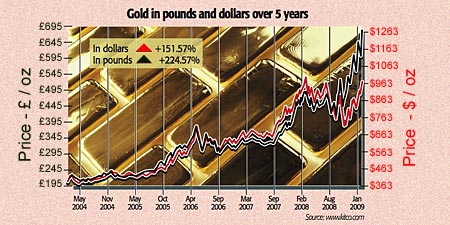
Talk about a gold rush. Last week the yellow metal jumped back above $1,000 an ounce – not far off last spring’s record of $1,033 – before slipping back on profit taking, raising its gains to 45% since October. Gold usually moves inversely to the US dollar, but it has gained around 13% this year, despite the greenback rising by around 10% against the euro. What’s more, it has hit new records in a range of currencies, including pounds (£690), euros and Canadian and Australian dollars.
There has been an unprecedented surge in investment demand, says Javier Blas in the FT. Investors in North America and Europe went on an “extraordinary shopping spree” for bars and coins in the final quarter of 2008, buying 811% more tonnes than a year earlier. Global retail investment jumped by almost 400%, with retail investors in France becoming net buyers of gold for the first time in 25 years. Inflows into gold exchange-traded funds (ETFs) have continued to surge this year. The gold holdings of the world’s largest gold trust, the New York-listed SPDR Gold Trust (NYSE:GLD), has absorbed 10% of worldwide annual mine output in the past seven weeks. It is now the world’s seventh-largest gold bullion holder, behind a handful of central banks.
The gold ETF boom is significant because it reflects the fact that a “huge” potential new market “has opened up for gold”, says Brian Lundin on Kitco.com. Gold investment has traditionally been the preserve of a minority of investors buying it on futures exchanges or through bullion dealers. “Only a very small percentage” of total available investment funds were ever allocated to it. But now, thanks to ETFs, retail investors can get in on the act. So the new market could be as big as the one for equities.
At this rate, 2009’s ETF purchases would be enough to surpass the tonnage of jewellery bought last year, replacing jewellery as the top source of demand, says John Jannarone in The Wall Street Journal. If ETFs keep growing rapidly they could start to create a “real squeeze” on the small gold market, given its limited supply. And supply is unlikely to rocket anytime soon. Mine production is still at levels seen in 2000, says Morgan Stanley.
There seems ample scope for investment demand to keep climbing. As the global downturn deepens, more bank collapses and nationalisations look likely, despite policymakers’ best efforts, says Lawrence Williams on Mineweb.co.za. So more and more investors are realising that “gold is about the only serious safe haven out there”. Gold “has always worked as a form of money and a store of value in troubled times”, says Robin Griffiths of Cazenove. And while its relative rarity makes it hard to reproduce, no government that has issued paper money “has been able to resist the temptation to print too much of it”.
Certainly, world governments now look set to “deplete the global ink supply in their money-printing efforts”, as they attempt to avert a slump, says Michael Santoli in Barron’s. That means that fears of currency debasement and the eventual return of inflation are growing, making gold look ever more appealing. Barclays Capital, for one, sees no sign of ETF demand slowing and has pencilled in fresh dollar highs for this year. Gold’s eight-year bull run is far from over.